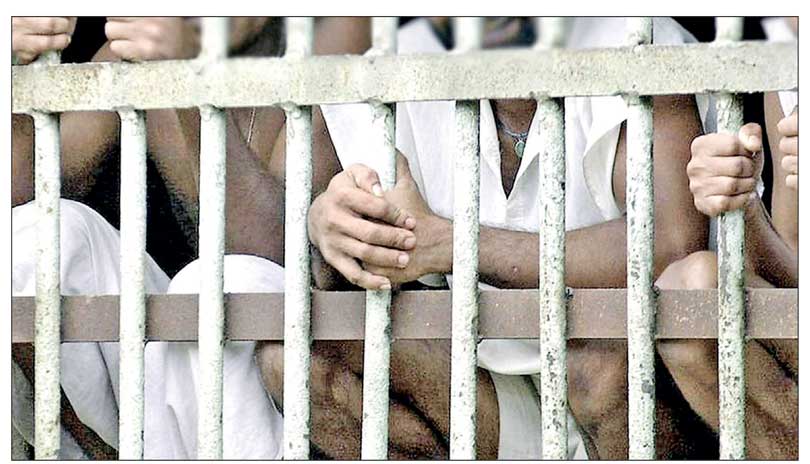Thursday Apr 24, 2025
Thursday Apr 24, 2025
Tuesday, 18 June 2024 00:03 - - {{hitsCtrl.values.hits}}

We need to ask political leaders what their plans are to drastically reduce over one million pending court cases and heavy overcrowding of prisons in the context of a national economic bankruptcy
Can a nation in bankruptcy pull itself out of this social doldrum, with a State apparatus that does not believe it has a responsibility towards the people who maintain them financially? Can a nation walk out of bankruptcy with political leaderships that have no serious thoughts about solving this social tragedy? They do not seem to know Sri Lanka’s bankruptcy is not just about external debts alone. No political leadership is heard belting out details on this social tragedy on their campaign platforms and in rallies as they do on fraud and corruption
 Last week, concluding their second review of the ongoing Extended Fund Facility (EFF) program, the IMF decided on 12 June to release the third tranche of $ 336 million from the agreed $ 2.9 billion soft loan that intends to support macroeconomic stability and debt sustainability in Sri Lanka. Thus, the third release would make a total of $ 1 billion to date. Declared intentions of the IMF program with Sri Lanka say, apart from macroeconomic stability and debt sustainability, it supports efforts to “mitigate the economic impact on the poor and vulnerable, rebuild external buffers, safeguard financial sector stability, and strengthen governance and growth potential.”
Last week, concluding their second review of the ongoing Extended Fund Facility (EFF) program, the IMF decided on 12 June to release the third tranche of $ 336 million from the agreed $ 2.9 billion soft loan that intends to support macroeconomic stability and debt sustainability in Sri Lanka. Thus, the third release would make a total of $ 1 billion to date. Declared intentions of the IMF program with Sri Lanka say, apart from macroeconomic stability and debt sustainability, it supports efforts to “mitigate the economic impact on the poor and vulnerable, rebuild external buffers, safeguard financial sector stability, and strengthen governance and growth potential.”
While mere hype without clear activities on poor and vulnerable, financial sector stability, and strengthen governance and growth would not have any worthwhile positive impact on the larger majority of the citizenry to improve on their living standards, they also do not indicate how Sri Lanka could repay its external debt. Debt restructuring certainly is not debt repayment. Accrued external debt at the end of December, 2023 was $ 54.8 billion and restructuring as I understand, would only increase that total over an extended period. There is also no assurance, with all reforms the IMF says are on track though not often on schedule, would allow this economy to develop its capacity to meet import costs in full even after the EFF program concludes in 2027 June.
This EFF program can only create space once again for the big city focussed free-market economy that for over 40 years could not earn enough foreign exchange to top up tea, coconut and minor crop export earnings and remittances from migrant employees to meet the annual import bill. In 2019, that’s 40 years after opening up trade and two years before warnings on the brewing economic crisis began, the foreign trade balance was a deficit of $ 05.14 billion. Total export earnings have been around $ 19 to 20 billion annually during the period 2016 to 2020. What was brought in by the privileged export manufacturers mainly from apparel, rubber and leather products, electric and electronic products and IT has been around $ 9 to 10 billion during that same period, when we needed around 15-to-16-billion-dollar income from them at a minimum.
This income is gross income as most products have an import cost for required raw materials that have not been audited for and deducted (numbers calculated from EDB, SLBFE, WB, Researchgate web sources). All this despite the cost the people had to bear through 40 years with tax holidays, tax concessions and discounts along with infrastructure facilities provided free for FDIs. They are huge benefits that has never been calculated in either dollars or in rupees. In short, pre-bankruptcy city-centred consumer economy the IMF is focused on is no solution to what Sri Lanka is going through even in terms of foreign exchange earnings.
Massive social tragedy
Sri Lanka is not only in a major economic crisis, but is in a massive social tragedy too, the result of this inherently corrupt free-market economy. Nowhere near a development model in any sense, the insanely corrupt free-market led all State agencies to inefficiency, corruption and social neglect and irresponsibility with no sense of the tragedy that would be left behind. Though “strengthen governance and growth potential” is mentioned in the IMF program that is not about turning around Sri Lanka’s inefficient and irresponsible State apparatus to a decent level of functioning to meet social needs. In the backdrop of the economic bankruptcy, the depth of this social tragedy is best understood with the two latest reports “Annual Performance Report – 2023” (https://parliament.lk/uploads/documents/paperspresented/1717762072030637.pdf) of the Ministry of Justice, Prison Affairs and Constitutional Reforms tabled in Parliament over a week ago and the report titled “Performance Audit on Management of Overcrowding in Prisons” compiled by the Auditor General’s Department (Report No.: JLO/C/D/DEP/2022/19 - National Audit Office).
The Justice Ministry performance report says, by end December 2023, the total number of cases pending in Courts amounted to 01.12 million. It also reveals, this has been an annual phenomenon with 713,527 cases pending in 2015 increasing to 01.12 million in 2023 within eight years. The ministry has since 2020 taken steps to increase the number of judges and courts. In 2023 the report says, 30 judicial offices were recruited and separate small claims courts were increased in Colombo, Kandy and Matara. With increasing numbers of pending cases getting piled up every year, which also means those who could be released on bail or could be acquitted also remain as inmates, the prisons have also over the past years got inhumanly overcrowded.
Prison overcrowding – intolerably heavy for a civilised society to bear with
The national audit office report on prison overcrowding reveals numbers that are intolerably heavy for a civilised society to bear with. It says, number of inmates that was held in prisons in December 2015 had increased by 139% of its capacity to 232% in December 2022. In short form what it means is, in December 2022 the prison system held 232% more inmates than it could. One does not need to say the status of other facilities like toilets, dining and sleeping space in prisons with such overcrowding. The report also says, the capacity of the prison system was increased to 13,241 in year 2020 from 11,762 inmate capacity there was previously.
Sadly, the monthly average of inmates in year 2022 had been 22,097, nearly double that of the increased capacity. That records an increase of 15% over the previous year monthly average. On that basis, the 2023 monthly average would have been 30,100 inmates. Please also note, these intolerable numbers do not include the said 30,000 detainees from the now infamous crackdown on the drug menace labelled as “Yukthiya”.
These two reports together say, the entirety of the law enforcement and justice system of the Sri Lankan State has failed the citizenry while swallowing large amounts of public funds allocated for them. They leave no doubts, every phase from receiving complaints, investigating violations and infringements of the law and with the Attorney General’s Department handling indictments, has a large part in this seldom spoken of social tragedy. They are therefore responsible for overcrowding of the prison system and for most cases that are pending. Added is the role of the private bar. Often accused of requesting “long dates” from the bench in dragging cases for their benefits, no doubt.
Can a nation in bankruptcy pull itself out of this social doldrum, with a State apparatus that does not believe it has a responsibility towards the people who maintain them financially? Can a nation walk out of bankruptcy with political leaderships that have no serious thoughts about solving this social tragedy? They do not seem to know Sri Lanka’s bankruptcy is not just about external debts alone. No political leadership is heard belting out details on this social tragedy on their campaign platforms and in rallies as they do on fraud and corruption.
Controlling and reducing social hiccups has never been a remedy
From what the two reports plainly say, political leaderships have gone with increasing capacities as solutions to these massive social breakdowns without questions. The only solution mentioned in the two reports is about increasing judges, court houses and prison capacities. With constructions also a part of solutions, none would want to think of alternatives. Controlling and reducing social hiccups has never been a remedy in Sri Lanka during the past decades. Therefore, reducing the social need for more judges, court houses and prisons has never been even dreamt of. Maybe they would also have increasing numbers of jail guards and police personnel too claiming their numbers for a thousand citizens here is far less than in most countries.
That is the logic in the health sector too. Increasing hospital beds, medical doctors and adding extremely expensive new hi-tech equipment for increasing numbers of patients with non-communicable diseases (NCD). This was what a World Bank story on Sri Lanka’s health system revealed on 29 March, 2022 in its website. “Non-communicable diseases, including diabetes, cardiovascular diseases, strokes and cancers, account for nearly 90 percent of the disease burden in Sri Lanka. The financial burden of NCD control and care is significant and not equally distributed, affecting rich and poor households differently.” Management and control of NCDs it says is about a strong focus on preventive care. “Reduce Numbers” is the answer it says.
We therefore need serious social discussions on these issues well in advance of elections, with a focus on preventing crimes, breaching of laws and on change of attitudes for a society that would be self-disciplined as a modern civilised nation. We need to ask political leaders what their plans are to drastically reduce over one million pending court cases and heavy overcrowding of prisons in the context of a national economic bankruptcy. Failing to generate such social dialogue with a loud voice, I fear election promises would be to increase magistrates and judges with 1,000 new court houses and a prison for every divisional secretariat with a capacity for 1,000 inmates. That being the political thinking for remedy on most issues sans solutions.
Discover Kapruka, the leading online shopping platform in Sri Lanka, where you can conveniently send Gifts and Flowers to your loved ones for any event including Valentine ’s Day. Explore a wide range of popular Shopping Categories on Kapruka, including Toys, Groceries, Electronics, Birthday Cakes, Fruits, Chocolates, Flower Bouquets, Clothing, Watches, Lingerie, Gift Sets and Jewellery. Also if you’re interested in selling with Kapruka, Partner Central by Kapruka is the best solution to start with. Moreover, through Kapruka Global Shop, you can also enjoy the convenience of purchasing products from renowned platforms like Amazon and eBay and have them delivered to Sri Lanka.
Discover Kapruka, the leading online shopping platform in Sri Lanka, where you can conveniently send Gifts and Flowers to your loved ones for any event including Valentine ’s Day. Explore a wide range of popular Shopping Categories on Kapruka, including Toys, Groceries, Electronics, Birthday Cakes, Fruits, Chocolates, Flower Bouquets, Clothing, Watches, Lingerie, Gift Sets and Jewellery. Also if you’re interested in selling with Kapruka, Partner Central by Kapruka is the best solution to start with. Moreover, through Kapruka Global Shop, you can also enjoy the convenience of purchasing products from renowned platforms like Amazon and eBay and have them delivered to Sri Lanka.